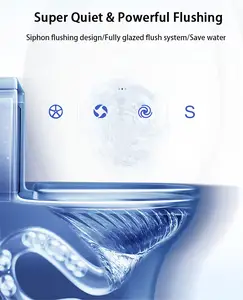Introduction
In the realm of home maintenance, the importance of a well-functioning toilet system is often overlooked. At the heart of this system lies the toilet waste pipe, a crucial component that ensures the smooth and hygienic disposal of waste. This article delves into the intricacies of toilet waste pipes, exploring their types, the factors to consider when choosing one, and the importance of regular maintenance. We'll discuss the pros and cons of different materials like PVC, cast iron, and copper, and provide insights into the installation process, cost, and environmental impact. This comprehensive guide aims to equip you with the knowledge to make an informed decision when choosing the best toilet waste pipe for your home.
Understanding the Importance of Toilet Waste Pipes
The toilet waste pipe, typically made of PVC, is a crucial component of your toilet system. It carries waste from the bowl into the main plumbing system. The pipe's diameter, usually three inches but can go up to four and a half inches, impacts the drainage speed and capacity. A broken or damaged waste pipe can lead to significant water damage, making it the most critical and costly repair in the toilet system.
Types of Toilet Waste Pipes
Toilet waste pipes, also known as flanges, come in various types. PVC or ABS Toilet Flanges connect water closet outlets to a plumbing system and sit flush on the floor surface. Cast Iron Toilet Flanges are designed for use on plastic or heavyweight cast iron soil pipe. Brass Toilet Flange Rings are used in older homes with a lead bend in place. The choice of toilet flange depends on the material of the pipe and connection method.
PVC Pipes
PVC pipes, made of a synthetic plastic called polyvinyl chloride, are a popular choice for plumbing, including toilet waste pipes. They are resistant to corrosion, unlike older materials like galvanized steel, clay, or cast iron. PVC pipes are available in different diameters and thickness levels, allowing for a suitable fit for any home. They are color-coded for easy differentiation: white for drains, waste, ventilation, and cold water supply; blue and dark gray for cold water; and green for sewer service. Despite their advantages, PVC pipes do have minor flaws, but they remain a cost-effective and reliable option.
Cast Iron Pipes
Cast iron used to be a common piping material for drainage systems, particularly in the first half of the twentieth century, and it can still be found in many homes today. Cast iron is extremely strong, durable, and heavy. It also reduces sound and is heat-resistant. Despite the advantages of strength and durability, cast iron is susceptible to rust over time. In homes that have cast iron piping, if a pipe rusts all the way through, you can replace it with plastic piping like PVC. Cast iron pipes come in various sizes, with the smallest usually being 4 inches.
Copper Pipes
Copper pipes have proven to be incredibly durable, able to handle pressure up to 1000 psi and withstand both cold and hot temperatures. They are less likely to freeze in winter and are resistant to corrosion from water. Copper pipes are also lightweight, making them easy to install. They are environmentally friendly, releasing fewer emissions during manufacturing and being recyclable at the end of their lifespan. However, copper pipes are more expensive than alternatives like PVC and may add a metallic flavor to water. They also may not withstand well water or water with high acidity levels.
Factors to Consider When Choosing a Toilet Waste Pipe
Several factors should be taken into account when determining the size of the toilet drain pipe. These factors include building codes, fixture units, distance to the main sewer line, and waste type. It's important to consult with a professional plumber to ensure accurate calculations and compliance with local building codes and regulations. The right size of drain pipe ensures smooth waste and water flow, preventing clogged pipes, backups, and other plumbing issues.
Durability
The durability of your toilet waste pipe largely depends on the material it's made from. For instance, PVC pipes, commonly used in residential sewer lines, can last up to 100 years. They are flexible and resistant to underground challenges like roots and shifting earth. On the other hand, cast iron pipes, which are stronger, also have a lifespan of 75 to 100 years. However, if you live in an older neighborhood, you might have a sewer line made of a less durable material, which lasts about 30 to 50 years.
Ease of Installation
Installing a toilet waste pipe can be a bit complex and requires intermediate DIY/plumbing skills. If you're replacing an old pipe, ensure the pipeline clears the hole in the flooring or wall and connects securely to the sewer drains. If you're moving the toilet's position, you'll need to carve out the hole yourself. Once the toilet is connected to the soil pipe, fix it to the floor using screws. Then, connect a new pan connector of suitable length. Use ABS glue to connect the two pieces, holding it under pressure for 30 to 35 seconds.
Cost
The cost of installing a toilet waste pipe can vary, but as of June 2023, it starts at $808 - $979 per drain. This estimate is based on mid-grade materials and basic work performed by qualified professionals. It's important to note that costs can increase if premium materials are used or if the project requires a master craftsman. For accurate cost estimation, consider factors such as location, project size, and specific options. Remember, these estimates are not substitutes for written quotes from trade professionals.
Environmental Impact
The environmental impact of toilet waste pipes is significant. Misconnections, where wastewater is wrongly directed to surface water systems, can lead to large-scale environmental damage. This untreated wastewater increases pollutants like phosphates and nitrates in water bodies, severely damaging soil quality and disrupting local ecosystems. The pollution also leads to a drastic decline in biodiversity. Therefore, choosing the right toilet waste pipe and ensuring its correct installation is crucial for minimizing environmental harm.
Maintaining Your Toilet Waste Pipe for Maximum Hygiene
The main thing you can do for your plumbing system is to clean drains once a week. This can be done easily with a little baking soda and apple cider vinegar. Simply pour the two substances down the drain and let it foam up before flushing the toilet. This will clear out any small clogs forming in your system. It is recommended you have a professional maintenance service done once a year to reduce the number of clogs you see as well. Only an expert is trained to see potential problems as well as things that are already causing problems within your plumbing system.
Regular Cleaning
Regular cleaning of your toilet waste pipe is crucial to maintain hygiene and prevent blockages. Minerals, bacteria, and other substances can build up in the pipes, causing drainage issues. By cleaning regularly, you can remove these substances before they start to clog. Products designed to remove tough stains and bacteria from your toilet bowl can be used. Their thick formula clings to the sides of the toilet to dissolve stains, dirt, and grime, effectively eliminating odours and keeping your bathroom fresh and clean.
Inspections and Repairs
Regular inspections and repairs are crucial for maintaining the health of your toilet waste pipe. A professional plumber can use a video camera to enter your sewer line and recommend repairs based on your situation. This can help identify issues such as clogs or damage that may be affecting the functionality of your toilet waste pipe. If damage is found, methods such as pipe bursting or pipe lining can be used to repair the pipe without the need for extensive excavation. Remember, a professional repair is more likely to be done properly the first time, avoiding recurring issues.
Proper Use
Proper use of your toilet waste pipe is crucial for maintaining the health of your household drainage systems. It's important to avoid clogs caused by excessive use of toilet paper or other non-flushable items. Over time, wear and tear can also affect the performance of your waste systems, necessitating maintenance or replacement. Ensuring the right waste goes down the right drain is vital. Misuse can lead to unpleasant disasters at home, so understanding your waste pipe system is key to avoiding such issues.
Conclusion
In conclusion, the choice of a toilet waste pipe is a critical decision that impacts the hygiene and functionality of your home's plumbing system. From understanding the different types of pipes to considering factors like durability, ease of installation, cost, and environmental impact, every aspect plays a significant role. Regular maintenance, including cleaning, inspections, and repairs, is crucial to ensure the longevity of your waste pipe and prevent potential issues. Remember, the right choice and proper care of your toilet waste pipe not only contribute to a well-functioning toilet system but also help in maintaining a clean and healthy environment. Armed with this knowledge, you can now make a more informed decision about your toilet waste pipe.










































 浙公网安备 33010002000092号
浙公网安备 33010002000092号 浙B2-20120091-4
浙B2-20120091-4